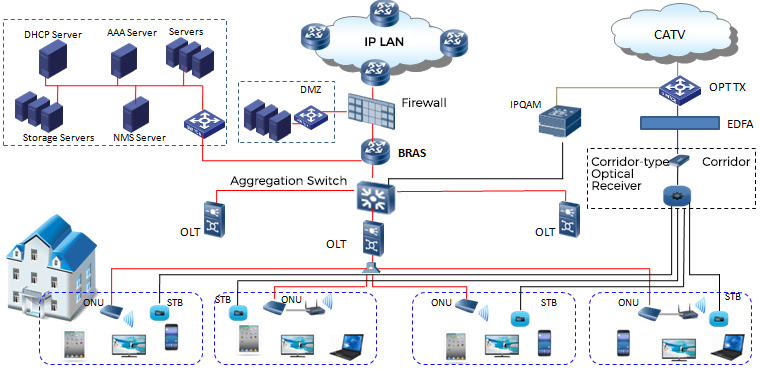Broadcasting and Television Two-Way Network Upgrade Solution
Overview
Since the pilot of Next Generation Broadcasting (NGB), the broadcasting and television industry has embarked on a comprehensive transformation and construction of two-way networks. After years of development, remarkable achievements have been made, and it has evolved into a comprehensive network service provider for multiple businesses. The FTTH (Fiber-to-the-Home) network architecture based on PON (Passive Optical Network) has become the optimal solution for current broadcasting and television network construction.

With the popularity of HD online videos and large-scale online gaming, the broadcasting and television network has transitioned from traditional one-way broadcasting to a high-speed broadband two-way interactive network supporting multiple services.
Solution
To meet the business requirements of broadcasting and television, BDCOM proposes the Optical Network Access solution, aiming to minimize user investment, protect existing network investments, and maximize returns with minimal input.
For existing networks, efforts are made to optimize investments and reduce input in terms of equipment and engineering. On the user side, the existing coaxial cable television network is maintained as much as possible, and only targeted broadband networks are newly constructed.
For new networks, a FTTH architecture is adopted, where the ONU (Optical Network Unit) is directly connected to the user premises, providing with high-speed broadband to meet various service demands, offering a comprehensive solution for broadcasting and television operators.
Revitalizing Existing Networks
● FTTH+ Coaxial Cable Mode

New Construction Network
● Dual-fiber FTTH mode

● Single-fiber FTTH mode

● Full IP mode

Solution Highlights
● Resource Saving: Point-to-multipoint network structure enables multiple optical nodes to share a backbone fiber, significantly reducing backbone fiber usage.
● Multi-Service Access: Provides comprehensive access capabilities for services such as television, voice, and broadband to meet various user requirements.
● High-Speed Bandwidth: Fiber-to-the-home architecture allows each user to be allocated with high-speed bandwidth.









































 Implemented Intercity Ring Metro-E Network Backbone with BDCOM 100G Switches in
Implemented Intercity Ring Metro-E Network Backbone with BDCOM 100G Switches in






